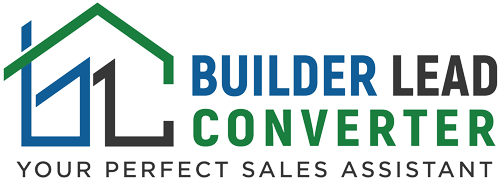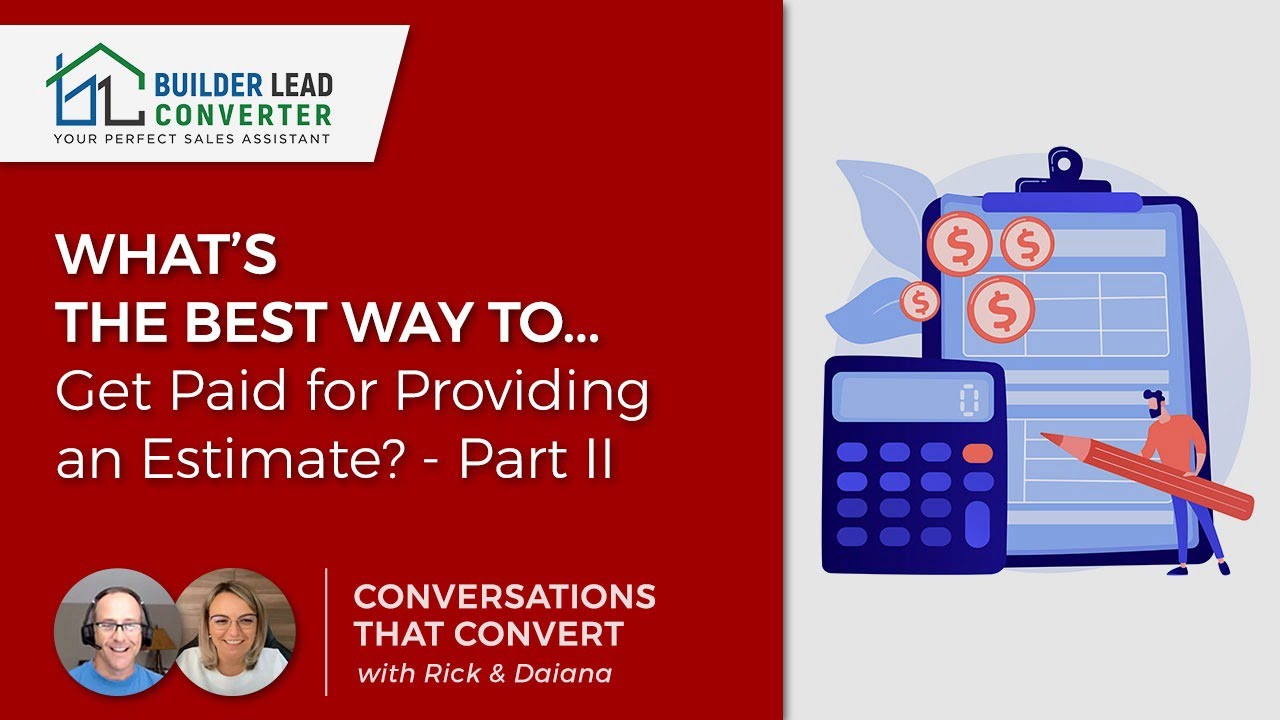When it comes to providing estimates and bidding projects, builders have surely heard the age-old adage “time is money”. The problem is, estimating takes too much time and builders are typically getting paid too little if not providing them for free.
In this part two of the three-part series, Builder’s Ask…‘What’s the best way to get paid for providing an estimate?’, we’ll look at two different options for how to calculate (and sell) estimating fees.
Whether you’re a full-fledged homebuilder or a small business working on remodels, finding out how best to structure your estimates can go a long way toward making sure you’re compensated properly every time!
So, if you’re interested in adding a new revenue stream from estimates, read/watch/listen to the full episode below.
Builder Lead Converter captures & converts leads for home builders & remodelers so they can grow sales revenue and margins. Find out how at https://www.builderleadconverter.com
Transcript:
Rick: Today on Conversations That Convert, we’re gonna talk about what is the best way for a builder to get paid for providing an estimate. Let’s get started.
Welcome to Conversations That Convert. Every week, we’ll spend about 10 to 15 minutes tackling relevant lead generation, marketing, and sales topics for remodelers, home improvement companies, and home builders. Conversations That Convert is brought to you by Builder Lead Converter, your perfect sales assistant. And now here’s Rick and Daiana.
Rick: Hi, Daiana. Happy New Year.
Daiana: Hi. Hello. Happy New Year to you too.
Rick: Let’s have –
Daiana: Officially our,
Rick: Yeah, officially our first live program for 2023. Here we go.
Daiana: Yes, A new year. A new start. So yeah,
Rick: And a new topic.
Daiana: New topic.
Rick: And a new topic as well. Yeah. What are we talking about today?
Daiana: So today is part one of three and we will find out what’s the best way to get paid for providing an estimate. So,
Rick: Exactly.
Daiana: Can you get, can you be paid for just providing an estimate? That’s amazing.
Rick: Well, you’re gonna have to listen in and find out. I, I,
Daiana: Yes,
Rick: I think so. Well, but, yeah, that’s something we will talk about. And of course, this is part of our Builders Ask series, and I am gonna be, I will be speaking at the International Builder Show here at the end of the month in Las Vegas. And the topic is building custom homes and remodeling jobs turning estimates into a revenue stream. So this will be a preview of that program, bits, and pieces, not nearly as in-depth or, or detail, but I’m really excited to be able to bring some of this information, and put it out, in, in the interwebs.
If you will, where if you can’t get to the International Builders Show, this is something that you can use to learn more about this topic and hopefully get paid yourself, but this is all based on a case study. So I have a client that has given me information. In 2022, they earned nearly $60,000 in what they call pre-construction fees. So they average about $4,500 per job. This is pure profit.
This is paid over and above what they got paid to remodel. And also of note, this is based on marking up their remodeling projects as 60% and custom homes, as 30%. Very, very profitable remodeler. And the thing that I, that we wanna convey is that there is no reason that you need to provide a3 free estimate, your time is valuable. You should be getting paid for it.
The information you’re providing is valuable. Your, prospective clients are willing to pay you for it. So, Daiana, you already let the cat out of the bag. We’re gonna be having three parts to this series. So part one is gonna be based on how to set the, how to set the stage with new leads on why they want to, want to pay for estimates. Then part two, we’ll look at different options on how to calculate and sell estimating fees.
So we’ll get into more of the sales process of it there. And then part three, we’ll be looking at streamlining, and estimating to become more time efficient and not only cover costs but to make, a profit. So again, today we will focus on setting the stage. So this all has to do with marketing, lead generation, and being able to develop a pool of prospective clients that know you and trust you and see the value, in what you’re doing. So what do you think, Daiana? Are you excited? Should we get started?
Daiana: Yes, I’m excited and that’s amazing. So congratulations, first of all, for visiting Las Vegas and for-
Rick: Ah, thank you. Yes, it is always fun to speak at the show and I haven’t been, I didn’t get to the show last year, so I’m excited to go back and it’s all it’s always better in Vegas.
Daiana: It is, it is. So good luck with that. So that’s,
Rick: Thank you.
Daiana: So exciting indeed. And looking forward to seeing the speech in advance.
Rick: Yeah. And that’s exactly what we’re gonna do. That’s what we will do. So part one, our goal for part one here today is to backlog leads. So we’ve heard this term backlog before, backlogging production, where we have more people that want to start jobs with us than we have the ability to start.
So we backlog people. So we tell them we can’t start them for three months or four months, or five months, or six months because we have people in front of them. We wanna do the same thing here, with leads. And so there’s a process to do this, and we’re gonna talk about that process today and try to help you understand what the mentality of the lead is.
What are some of the keys to being able to charge, for estimates? How do you develop high-quality leads? And ultimately how you want to position yourself when you ask for that payment. And, and so it, it is a, it’s part art, it’s part science, but really what it starts with is understanding what do your leads looking for. So, Daiana, you’ve remodeled. What? Two times now. Is that right? Recently.
Daiana: Yes. Two times. So.
Rick: First time was good. Is second time was not so good, right?
Daiana: Not so good? Yes.
Rick: Not so good. So, there were two questions that you had before you remodeled the first time. Do you remember what those questions were?
Daiana: Yes, I, I wanted to know the price of course, and, and the design, how, how it’ll look like in the end.
Rick: That’s right.
Daiana: So I was curious to see because I’m visual and I wanted to see the final, the final project, and of course the price.
Rick: Right? And, and it, and then, the order that people ask is they want to know what first, what can my home look like? What you know for whether I’m building a new home, whether I’m remodeling my kitchen. I can’t visualize what that looks like. So question number one is always what will it look like? And then once somebody decides on what it’s gonna look like, so they have the plan done, they have the selections and specifications, et cetera, then the next question is, okay, how much? How much is it going to, going to cost? And so we need to understand every lead is trying to answer those two questions. If they’re building a home, they may also have a question about where. Where I can build that home?
I need, they need to find a lot. Some people already have a lot, so they’ve answered that question. Then it comes down to what and, and how much. So we call that product and price. The product would be the design. The price, of course, is the budget, the final cost, to do that. Every lead has those two questions.
So we need to understand what they’re looking for upfront, and the key to charging for estimates is to have more than enough high-quality leads to fill their production slots. So I’m a big proponent of product selling. You all have the ability to start and close a certain number of jobs every single month. So that might be one a day, it might be one a month, but you understand what your production capabilities are. So our goal then is to make sure we have more than enough high-quality leads, and affiliate production slots.
And ironically, the Association of Professional Builders just got done serving over a thousand builders here across multiple continents, and their number one marketing problem was high-quality leads. So it’s, it’s no wonder, right? I mean, it’s like everyone wants high-quality leads. It’s one thing to have a lead. It’s not the only thing to actually have a high-quality lead. Leads don’t buy.
They waste your time. High-quality leads, buy. So we’re gonna talk about today is like, how, how do we have more than enough high-quality leads to fill our production slots? So again, if we’re gonna start three jobs per month. We wanna make sure we maybe have six high-quality leads, assuming we have a 50% conversion rate. Now to do that, we have to use, something we call multi-channel lead generation. There’s a difference between leads. It’s based on the lead source. So multichannel lead generation is where you identify where you typically find high-quality leads. And those are gonna be, those will be organically obtained. So, when I say organic, Daiana, what do you think of it?
Daiana: Meaning that you, you will not pay for that. You’re not-
Rick: Exactly.
Daiana: Pay for advertising. So they, they will and they will come to you after they see your marketing content.
Rick: That’s right. Yep. It’s called opt-in permission-based marketing. They come, inbound marketing is another term for it, but it’s where they come to you. Okay. So that is organic marketing. So it’s going to come from your website and your social media. It might be sign calls. It’s gonna come from your referral partners, not only your clients but also, your B2B referral partners. We talked about that a few episodes ago about setting up those parameters. That’s where your best lead sources are. Because those are the leads that typically convert. Your lowest-quality leads are always gonna come from paid ads.
Daiana: Yes,
Rick: Or perhaps like a walk-in. They don’t know you, they see an ad, they click, they’re not sure why they’re thinking about doing this, or they, perhaps just want to get a price. Always the low-quality lead, a lower conversion rate. So what we wanna do with our multi-channel lead generation is we wanna build a database of leads who are early in the process.
And that gives us time to create trust and value. And that’s exactly how it works. I talked about if I am a homeowner and I wanna remodel my kitchen, the first question I have is, what can I look like? And then once I find something where I, I go, oh, this is wonderful. I want it to look like this. My next question is, I want to get a price. Well, it’s the same thing in developing a relationship with, a lead. The first thing they have to do is they have to trust you. If they don’t trust you, you’re not gonna buy. Are you gonna buy from somebody you don’t trust, especially spending thousands of dollars?
Daiana: No,
Rick: No.
Daiana: Absolutely.
Rick: Absolutely not. Absolutely not. Women especially do not buy from people that do not trust. So once I trust you, then I have to see the value in what you’re providing me and the number one value proposition that builders offer is their expertise. It’s their team, it’s their experience. It’s, it’s their ideas, it’s their process that they bring to the table. And obviously, you had two remodeling experiences. One was good, one was not so good, right? So the one that was good, you’re like, oh, great, this is wonderful. Everything worked great. The one that was not so good, It’s like, get outta my house. And I think you did kick him outta your house, didn’t you?
Daiana: Exactly. Yeah. That was, yeah.
Rick: Yeah. I, You fired, you fired your builder, which, we never wanna have to happen.
Daiana: Yes,
Rick: But it, you know, it comes to the point where you just don’t trust them anymore. You don’t see value in what you’re, they’re doing. I don’t care how much you want to charge me, I’m not willing to do business with you. Get out. And, and that’s how relationships break down, or that’s why people don’t buy because either they don’t trust you or they don’t see the value in what, in what you doing.
So we build this database. We find people early in the process, and then we have time. We create trust and value. Now, going back to where does every lead start? They wanna know what is it gonna look like and how much will it cost. So we want to answer those questions without answering those questions. I’ll say that again.
You wanna answer the questions without answering the questions. Now you should be thinking, Rick, what are you talking about? This is nuts. How can I answer somebody’s question without answering the question? We shift over to our process. Okay?
So we show them how if they use our process, we will give them the answers that they are looking for. So in that sense, if I say to you, Daiana, I am, I want to get you the information you’re looking for. We want to talk about design. We want to talk about pricing, this is the process that we are going to use to get you that information. Okay? So that’s what we wanna switch.
Instead of me saying, starting throwing out numbers or starting throwing out design ideas, I may do that, but I want to do it very, what’s the word I’m looking for? I want, I want to have it be vague, but I wanna focus more on our process and why the lead wants to use our process. One of the important things is, as I was interviewing, the builder for this case study, he made a good point that I have to share with the lead about why they don’t want to go out and get three estimates, three free estimates.
I have to tell them the pitfalls, what are the problems with that. So we’ll get into that more, in our, in part two. An important thing that I, I guess want to end today is, is this, is that if we come in through this relationship. We position ourselves as a builder, we’ve essentially commoditized ourselves. So now the value we bring to the lead is telling them how much it’s going to cost, and sometimes we get leads like that.
They’ll say How much? How much? How much? And there are a lot of different ways to answer that, but, the answer really is, I can’t tell you how much because I do not know what your project is yet. And you know, from going through this process, Daiana said you have to, you have to design a floor plan. You have to pick selections, you have to, have to have a scope of work, and all those selections will be installed. All those things will determine what the price is. So what we wanna do is position ourselves as consultants first, not a builder. We’re a consultant. Because if you think of it this way, if you go talk to your attorney, does your, as a consultant, does your attorney charge you for their advice?
Daiana: Yes.
Rick: Yeah. The attorney charges you for For their advice. Absolutely. If you go talk to your dentist or doctor. And you have, I just had, I just had a root canal. It sounds horrible. It sounds horrible, but it wasn’t as bad as you, it sounds. Yeah. I had to go to my dentist’s. He looked at my tooth, and he charged me.
Daiana: Right.
Rick: For to coming, to see them. I go to my doctor, I go to my accountant. I wanna ask them something about my taxes. I have to pay them. They’re my consultant. So what you wanna do is position yourself as a home building advisor or a, or a remodeling adviser. As a consultant, and this is where I wanna leave you with today, is this idea of kicking the tires prior to the big commitment.
So I think the analogy is if you’ve ever had any legal issues and you go to an attorney. The attorney, the first thing that they will start with is they’ll say, Daiana, let, I’m gonna write a letter. To this entity that you’re having the problem with, and I will put on there, this is what you want to have to happen. And in order for me to write that letter, I will charge you, let’s just say it’s $600, $700. Pick a number, and I’ll charge you that much.
And then the attorney will say, now here’s what could happen going forward. They may respond positively and we will we’ll able to resolve this. Okay. And all you had to pay me for was the letter. However, they may not respond the way you wanted to respond. And these are your next steps. You have to go deeper into the legal legality of this issue.
Daiana, I’d be happy to help you with that. But in order for you, for me to do that, you’re gonna have to pay me a retainer of $10,000. So what you’re doing that attorney is doing is he’s allowing you to kick the tires so he can show his expertise in the letter. And if you have to go forward to that $10,000, say retainer, you at least have established that you trust this attorney. You value his or her opinion before you make that big commitment. Well, this is the same thing here. You allow someone to kick the tires with you by developing, a relationship based on a few hundred or a few thousand dollars prior to actually starting the job.
So I get to go through that design process with you. I get to learn about your expertise. I get to work with your team. I’m gonna make some selections. I’m gonna see how, what it’s like to communicate with you, and after that process, I’m gonna say, wow, you are incredible, Daiana. I love your ideas. Okay, let’s get married. We’re done dating. Let’s get married. Let’s go for the big commitment. Let’s remodel a house. Let us let’s build the new home. So that’s what it’s all about here high-quality leads who see the value of what you do, who trust you, who are willing to pay you to answer their two questions on what is it gonna look like and how much is it gonna cost. Any final thoughts, Daiana?
Daiana: Well, that’s, that’s amazing. So focus on the process. That’s the key when they ask about the price and the product and you just shift the attention to the process and when they see the process, they get the value. And then you move, to marriage.
Rick: That’s right. If I trust my attorney. I asked my attorney, okay, what are the, what’s the next steps in trying to resolve this, this issue?
Daiana: Right?
Rick: I trust them. I, I see value in what they’re doing. The attorney lays them out and says, okay, if we go do this, this, and this, this is what it could potentially cost you. I do the same thing with my home builder or my remodeler. What is the next step, Mr. Builder? And the builder says, well, this is what we’re going to do, and in order to do these steps, this is what we’re going to charge to get you the information that you’re looking for so you can make a well-informed choice before you make the quote-unquote big commitment.
Daiana: Right?
Rick: Simple as sounds simple, it’s a little more complicated than that, but that is, in essence how we get our leads to understand why they would want to pay us for our expertise. So if you are interested, in looking at this, you can go ahead and schedule your strategy, call right below and find out how we can help you capture and convert leads so you can start acquiring clients in, a tough market and get paid to provide estimates. So until next time, for my brothers and sisters in Christ, may the grace of the Lord Jesus Christ, the love of God, and the Fellowship of the Holy Spirit. Be with you all. Always we’ll see you next time with part two. Have a good day everyone. Bye-bye.
Daiana: Take care. Bye.






Recent Comments